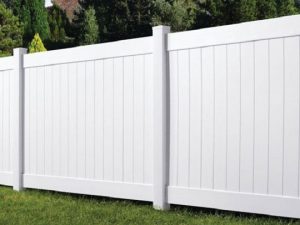A fence can enhance your home, beautify your yard and safeguard your children and pets; choosing the right materials for this important feature ensures you get a lasting, attractive fence you will benefit from for years to come. You have several choices when it comes to your home fencing; the primary options are PVC or wood. Learning more about your options allows you to make the right choice for your home. Consider the durability, maintenance needs, appearance and more when you choose your fence and you will be delighted with the outcome.
Wood vs. PVC: Which Fence Material is Right for Your Home?
Wood was once the only choice for home fencing, but the low maintenance appeal of PVC has made this affordable material more popular than ever before. These two materials vary in several key ways, from cost to maintenance and long lasting durability.
Flexibility: Both wood and PVC fencing come in a wide range of styles, from privacy fencing to old fashioned pickets and decorative trim. PVC fencing can even emulate wood fencing, with a natural, defined texture and old-fashioned charm. You can get a look that enhances your home and curb appeal with either of these fencing materials. Since wood can be painted, you have a wider range of colors and finishes, for those willing to commit to annual painting — or painting every other year, wood can offer more flexibility. If you want a traditional white fence, PVC never needs to be repainted; the material itself is white, so no other surface treatment is required.
Durability: Wood, even cedar or wood that has been pressure treated, has a definite life span; after some time has passed, a wood fence will begin to show its age. Wood fences are exposed to the elements year round; regular rain and temperature changes take a toll on wood fences and begin to erode their structure over time. This leads to the need for replacement over time. A PVC fence does not erode over time and since PVC is the material used for water pipes, does not sustain water damage. If you need an enduring, lasting fence that looks as good years from now as it does on the day of installation, PVC is the best choice for your project.
Maintenance: Because a fence is outdoors and exposed to the elements, it is directly impacted by the weather. A wood fence will swell and contract with humidity changes and differences in temperature. This can lead to warping or curving over time; some pickets or planks will need to be replaced as these changes occur. A painted wood fence will need sprucing up each year, and the same humidity that impacts the curvature and texture of the fence can also lead to peeling and chipping of the painted surface. Because of these factors, a wood fence will need annual maintenance and upkeep to stay in shape.
In contrast, a PVC fence will not warp or peel over time. This leads to fewer maintenance tasks and virtually no painting or detail work. This style fence is easily cleaned and refreshed at the start of the season and rarely needs attention beyond simple cleanup tasks.
Costs: Wood fences may seem less expensive at first, particularly for those who take a DIY approach. The cost of pickets and planks does not include waterproofing, paint or finishing, which will increase the cost. Cedar and basic PVC are very similar in cost, while more decorative finishes of both materials are more expensive than basic, unfinished wood. Figure in the cost of materials, finishing supplies on ongoing maintenance and repair when you determine your long term fencing costs.
For those who want a truly traditional material and who do not mind the added maintenance and work, wood remains a classic choice. For homeowners who want a low maintenance, affordable option that will last for years, PVC is the better choice. Learn more about your options and see what beautiful, lasting PVC fencing can do for your home — get in touch today to see what this striking material can do for you.




